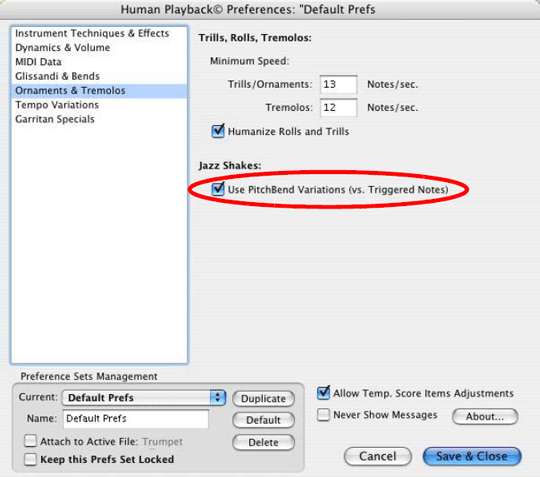articulation 
smart shape: downward note-attached gliss or tab slide followed by rest
articulation 
smart shape: upward note-attached gliss or tab slide followed by rest
The techniques you’ve learned so far can be applied to files using either the full Garritan Personal Orchestra, the Instruments for Finale or SmartMusic SoftSynth. But many of the other sound libraries you may choose to use will have additional considerations or techniques for best results and best performance from your computer.
In late 2005, Garritan introduced Garritan Jazz and Big Band (or JABB for short), the first instrument library of its kind. It contains high-quality samples of most of the instruments commonly used in jazz scores, including saxophones and other reeds, trumpets, trombones, rhythm section instruments, and more. Human Playback has been updated to take advantage of the features offered by JABB. For the most part, using JABB instruments is no different from using other Garritan instruments, but there are some issues that are unique to JABB that you should be aware of.
All of the JABB trumpets and trombones (including the "Lite" instruments) come in Keyswitched versions that allow you to easily switch between a variety of commonly-used jazz mutes and open playing. When you load a keyswitched trumpet or trombone (the ones with "KS" in their name, e.g., "Tpt 1 KS" or "Bass Tbone KS Lite"), Human Playback will automatically interpret expressions like "bucket," "cup," "harmon," and "mute out," without any additional effort required.
Note. Not all Garritan instruments have keyswitched versions available. In Garritan Instruments for Finale, only the strings, harp, and timpani come in keyswitched versions. Full GPO has many more keyswitched instruments, and some instruments (like the strings) have additional keyswitches not found in Garritan Instruments for Finale. In JABB, the trumpets, trombones, guitars, and basses all come in keyswitched versions.
These expressions can even be contained inside JazzText enclosures - Human Playback ignores the enclosure characters and looks for the word. For more information, consult the section on Keyswitches.
The JABB trumpets (but not the "Lite" trumpets) include sampled release effects, like fall-offs and doits (i.e., upwards fall-offs). These are automatically triggered by Human Playback when certain articulations or smart shapes are attached to a trumpet note, positioned to the right of the notehead, and followed by a rest. The length and speed of the fall-off or doit is fixed and is unaffected by the shape of the articulation or smart shape. See the following table for details:
| Effect | Trigger |
| Fall-off |
articulation smart shape: downward note-attached gliss or tab slide followed by rest |
| doit |
articulation smart shape: upward note-attached gliss or tab slide followed by rest |
Note. Doits and fall-offs can only be triggered by trumpet notes sounding the F above middle C or higher. JABB does not include release effects for trumpet notes below that range.
JABB wind instruments (but not the "Lite" wind instruments) use MIDI controller #18 to create a growl or fluttertongue effect. Human Playback automatically takes advantage of this controller to create authentic growls or fluttertonguing whenever a tremolo articulation (æ) is attached to a note.
In most jazz scores, a wavy line or trill indication above a note in a brass instrument's part indicates a rapid lip trill, called a shake. In the Ornaments and Tremolos pane of the Human Playback Preferences dialog box, there is an option to interpret a horizontal wavy line - either the Smart Shape or the ~ articulation - as a pitchbend trill, which more accurately resembles a jazz shake:

Note. Even with this feature enabled, the Smart Shape trill tool will continue to trigger regular (keyed) trills. Pitchbend-based shakes are only triggered by a horizontal wavy line without the "tr" prefix.
A common basic jazz articulation is for players to tongue offbeat eighth notes and slur onbeat eighth notes. Human Playback automatically supports this tonguing pattern when using JABB instruments. For more information, see the entry on Human Playback Preferences.
When it comes to memory and (especially) processing power, users should be aware that JABB instruments are even more demanding than GPO instruments. The minimum system requirements are 1 GB of RAM and a 1.8 GHz G5 or equivalent (Mac), or a 2.4 GHz Pentium 4 or equivalent (Windows), and that is for small ensembles of 5-6 instruments. For users who wish to use JABB to play back a score written for a full 17-piece big band, the system requirements are even higher. Fortunately, JABB instruments (including the "Notation" instruments used by Finale) also come in "Lite" variants that are not quite so demanding, and allow users who meet the minimum system requirements to use larger ensembles. However, these "Lite" instruments lack some of the features included in the "full strength" JABB instruments. It is also possible to use a combination of "Lite" and regular JABB instruments in the same score. For more information, consult the JABB documentation, as well as the section on Performance Tips.
For more information on drum set parts and JABB, please see the section on Percussion.
 Previous Previous
|
| User Manual Home |

|